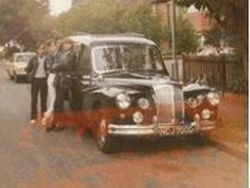 NCJ 700G
NCJ 700G by Paul Edwards 7th April, 2015
The majority of us will only ever take one ride in a Hearse. Hopefully it will be something with a little class. No offence intended, but personally, I would rather not make my final trip in a dodgy cut and shut Granada estate, even if it has the Cosworth motor.
There are two obvious ways to ensure that the last ride won’t be the only one that you take in such a form of transportation. Either work for a funeral director – not a business that’s ever going to be short of customers – or buy one.
In 1984, I persuaded my then boss to do exactly that, purchase a ‘68 Daimler Majestic Major hearse, NCJ 700G, from a coachbuilder in Gerrards Cross. As the company that my boss owned was a small engineering service company, it was, of course, an obvious addition to the fleet of Transits and diesel Pug vans that filled the yard. There was also my promise that I would buy the Majestic from him as soon as I could afford to do so. The £450.00 asking price was more than a month’s salary then, so we both knew that that might take a while.
At that time, the Thames Valley Trader was the weekly publication most pawed by men of all ages. Exchange & Mart had no photographs, and ‘Internet’ was a suggestion that at weekends you wore stockings. Alone.
Peter, the firm’s ace mechanic and myself went off to see the old lady and make the decision. The body shop was a thing to behold. I would have been 19 years old then, listening to a lot of metal and punk, so a huge hangar full of Mason’s black wagons was a kind of heaven in itself. I recall being very taken with a Rolls-Royce Silver Shadow in box carrying form, truly beautiful, but more than a little beyond budget. I could have – and would have, stayed there all day watching the coachbuilders at work. Really, how many of us have the opportunity to see that craft in practise? Hand shaping panels and roof pieces; it was all rather beautiful.
The Majestic was in a corner, very dusty, but all there, with very few marks or dents visible. She fired up first time with a proper V8 rumble. Peter was happy that the 4 ½ litre mill would keep running and off we went. I had never driven an automatic before then, let alone one with a column change that also happened to be 20 odd feet long.
Out onto the A40 and back towards Heathrow, our yard being in West Drayton. Prior to this day, I had always thought that the guys driving in black & white films had continually moved the steering wheel for effect, but it was now clear to me that that was the only way to keep pre 1970’s cars in a straight line – a prejudice based entirely on my first drive in the Majestic.
The majority of us will only ever take one ride in a Hearse. Hopefully it will be something with a little class. No offence intended, but personally, I would rather not make my final trip in a dodgy cut and shut Granada estate, even if it has the Cosworth motor.
There are two obvious ways to ensure that the last ride won’t be the only one that you take in such a form of transportation. Either work for a funeral director – not a business that’s ever going to be short of customers – or buy one.
In 1984, I persuaded my then boss to do exactly that, purchase a ‘68 Daimler Majestic Major hearse, NCJ 700G, from a coachbuilder in Gerrards Cross. As the company that my boss owned was a small engineering service company, it was, of course, an obvious addition to the fleet of Transits and diesel Pug vans that filled the yard. There was also my promise that I would buy the Majestic from him as soon as I could afford to do so. The £450.00 asking price was more than a month’s salary then, so we both knew that that might take a while.
At that time, the Thames Valley Trader was the weekly publication most pawed by men of all ages. Exchange & Mart had no photographs, and ‘Internet’ was a suggestion that at weekends you wore stockings. Alone.
Peter, the firm’s ace mechanic and myself went off to see the old lady and make the decision. The body shop was a thing to behold. I would have been 19 years old then, listening to a lot of metal and punk, so a huge hangar full of Mason’s black wagons was a kind of heaven in itself. I recall being very taken with a Rolls-Royce Silver Shadow in box carrying form, truly beautiful, but more than a little beyond budget. I could have – and would have, stayed there all day watching the coachbuilders at work. Really, how many of us have the opportunity to see that craft in practise? Hand shaping panels and roof pieces; it was all rather beautiful.
The Majestic was in a corner, very dusty, but all there, with very few marks or dents visible. She fired up first time with a proper V8 rumble. Peter was happy that the 4 ½ litre mill would keep running and off we went. I had never driven an automatic before then, let alone one with a column change that also happened to be 20 odd feet long.
Out onto the A40 and back towards Heathrow, our yard being in West Drayton. Prior to this day, I had always thought that the guys driving in black & white films had continually moved the steering wheel for effect, but it was now clear to me that that was the only way to keep pre 1970’s cars in a straight line – a prejudice based entirely on my first drive in the Majestic.
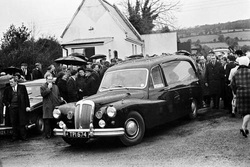 Daimler DR450 Hearse
Daimler DR450 Hearse She was, however, very, very smooth – and surprisingly fast. Peter had told me to watch the shaky speedo needle – and eventually I actually did. The auto box changed up and down in that way that they only ever do when married to a fair sized V8 – and oh, that sound.
So then, we arrived back in the yard to a round of applause. Until I could afford to buy it, NCJ 700G would be my company van – meaning that the firm would pick up most of the petrol bill. There was, of course, some ribbing to be done, I was just a kid at the time. It began happily enough - ‘no more driving it until it is clean’.
Two hours later, she was gleaming inside and out, the older blokes on the crew having taken great delight in making me clean out the storage section under the coffin shelf. Oh, yes, they’re double-deckers, didn’t you know? Yes, I had to crawl into that space with a dustpan and brush. Never mind, that done, I took to gently waxing the acres of walnut veneer and furniture polishing (tut, tut) the leather on the massive bench seat – and the pall bearers single seats. Yes, I opened the bonnet. Yes, I cleaned everything that was visible there too. I stopped short of polishing the aluminium, well everything, but I gave the inner wings and all of the plastics a good going over.
So, then – she was gleaming. Gleaming, but not legal. As a working girl, she wasn’t required to hold an M.o.T. and with the weight there came a general fear that the Majestic might have to be plated, and that was never going to happen. Only one garage in Drayton had a pit rather than a ramp for M.o.T.s and Peter, whose gypsy family still had picking rights in the area, had fallen out with the owner over a scrap metal deal. I should perhaps explain picking rights. This means that certain people have the legal right to go onto Council tips and landfill sites to pick for metals and other valuables. It was uncommon even then, and almost certainly does not exist at all now.
Peter told me to drive and he had a word with the owner when we got to the garage. That day I saw the fastest man alive. In the queue before the Majestic was a 60’s Mini. The bloke doing the test was already in the pit when the Mini was rolled over. He was checking the sub frames of course and then, as was still done in the early 80’s, he started prodding about with a screwdriver. Straight through the petrol tank it went, showering him and the roll-up sticking to his bottom lip in two-star. I didn’t actually see him move, I just became aware that he was standing next to me, shouting obscenities at the Mini’s owner while various brave souls pushed the thing back out into the street and left it cocking its leg against the kerb.
So then, we arrived back in the yard to a round of applause. Until I could afford to buy it, NCJ 700G would be my company van – meaning that the firm would pick up most of the petrol bill. There was, of course, some ribbing to be done, I was just a kid at the time. It began happily enough - ‘no more driving it until it is clean’.
Two hours later, she was gleaming inside and out, the older blokes on the crew having taken great delight in making me clean out the storage section under the coffin shelf. Oh, yes, they’re double-deckers, didn’t you know? Yes, I had to crawl into that space with a dustpan and brush. Never mind, that done, I took to gently waxing the acres of walnut veneer and furniture polishing (tut, tut) the leather on the massive bench seat – and the pall bearers single seats. Yes, I opened the bonnet. Yes, I cleaned everything that was visible there too. I stopped short of polishing the aluminium, well everything, but I gave the inner wings and all of the plastics a good going over.
So, then – she was gleaming. Gleaming, but not legal. As a working girl, she wasn’t required to hold an M.o.T. and with the weight there came a general fear that the Majestic might have to be plated, and that was never going to happen. Only one garage in Drayton had a pit rather than a ramp for M.o.T.s and Peter, whose gypsy family still had picking rights in the area, had fallen out with the owner over a scrap metal deal. I should perhaps explain picking rights. This means that certain people have the legal right to go onto Council tips and landfill sites to pick for metals and other valuables. It was uncommon even then, and almost certainly does not exist at all now.
Peter told me to drive and he had a word with the owner when we got to the garage. That day I saw the fastest man alive. In the queue before the Majestic was a 60’s Mini. The bloke doing the test was already in the pit when the Mini was rolled over. He was checking the sub frames of course and then, as was still done in the early 80’s, he started prodding about with a screwdriver. Straight through the petrol tank it went, showering him and the roll-up sticking to his bottom lip in two-star. I didn’t actually see him move, I just became aware that he was standing next to me, shouting obscenities at the Mini’s owner while various brave souls pushed the thing back out into the street and left it cocking its leg against the kerb.

The Majestic was going to cover the whole pit and the tester knew it. There wouldn’t be any way out from underneath should anything similar occur. He smoked another roll up and told me to bring it on.
She failed of course, but only on steering, everything else was in perfect working order. Pit man told Peter how to sort it out and we drove back to the yard. Obviously, no plug in and play with your ECU here. Peter stripped down the steering and on the spot manufactured some shims and rubbers, tightened the lot up as much as he dared and a day later we were legal. And it was Friday.
The Feathers Public House in Rickmansworth is on a tight bend and adjacent to a walled 17th century graveyard. It was also my local. The Majestic was simply too long to fit into the car park, so I left her on the pavement, mostly in the road and went in for a pint. Audi Quattro? Forget about it. Porsche 911? So what. If you want some auto attention on a summer’s eve in Hertfordshire, turn up in, well, I’m sure you know by now - a hearse - and park it on the pavement near a slightly neglected church.
I did exactly that every night for a few weeks and, one Thursday, was summoned to the public bar by Percy, the landlord at that time.
‘I've had a visit’, he started, ‘About the car’.
‘Oh, right,’ I answered, thinking that I was in for one of his legendary telling’s off, which occasionally ended in the too small car park, particularly if a punters actions had brought the completely unwelcome local constabulary onto the premises.
‘Who from?’ I continued.
‘From Peddle, the undertakers’ he explained.
‘Oh, right, what did they say?’
‘They said that they’ve had complaints, and think that they’ve lost business because the hearse is parked outside a pub every night of the week.’ He did not look at all pleased. Much of his trade came from other local businesses, particularly at lunch times.
She failed of course, but only on steering, everything else was in perfect working order. Pit man told Peter how to sort it out and we drove back to the yard. Obviously, no plug in and play with your ECU here. Peter stripped down the steering and on the spot manufactured some shims and rubbers, tightened the lot up as much as he dared and a day later we were legal. And it was Friday.
The Feathers Public House in Rickmansworth is on a tight bend and adjacent to a walled 17th century graveyard. It was also my local. The Majestic was simply too long to fit into the car park, so I left her on the pavement, mostly in the road and went in for a pint. Audi Quattro? Forget about it. Porsche 911? So what. If you want some auto attention on a summer’s eve in Hertfordshire, turn up in, well, I’m sure you know by now - a hearse - and park it on the pavement near a slightly neglected church.
I did exactly that every night for a few weeks and, one Thursday, was summoned to the public bar by Percy, the landlord at that time.
‘I've had a visit’, he started, ‘About the car’.
‘Oh, right,’ I answered, thinking that I was in for one of his legendary telling’s off, which occasionally ended in the too small car park, particularly if a punters actions had brought the completely unwelcome local constabulary onto the premises.
‘Who from?’ I continued.
‘From Peddle, the undertakers’ he explained.
‘Oh, right, what did they say?’
‘They said that they’ve had complaints, and think that they’ve lost business because the hearse is parked outside a pub every night of the week.’ He did not look at all pleased. Much of his trade came from other local businesses, particularly at lunch times.
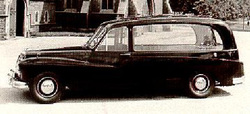
‘Sorry,’ I started, ‘I’ll move it now and I’ll, err, park somewhere else, ok?’ I said, taking a slight step backward.
Taking me gently by the throat he spoke directly at me…
‘No, you won’t. What you’ll do is park it there, just where it is, every night until I say otherwise, is that clear?’
I nodded, quizzically.
‘I will not,’ Percy continued, ‘Have some jumped up arse in a black overcoat telling me what I can and can’t do in my pub. Oh, and you can leave it here tonight, put it in the entrance to the car park when everyone’s gone. Large Scotch?’
I was less a question than an order. I drank it, though and several others besides. The Majestic spent the night in the pub car park. I got home.
During this time, I had a lot of fun with men my age who were driving – well, anything that they could afford – or that their parents would lend them. Traffic lights, one Majestic, one Capri/Chevette/Maestro whatever – and hey presto, leave ‘em in the dust.
The local Police soon got used to seeing the car late at night – and, knowing that I would be sober, stopped pulling me over for a laugh after a few months. I think for a couple of young officers, it became a bit of a ritual – at least, the older copper was always the same bloke.
Running costs were, of course, astronomical, but as I wasn’t paying for most of them, that didn’t bother me at all. The Majestic was very easy to drive, the power assist on steering and brakes was superb, and the turning circle was tiny, in comparison with many modern cars.
Reverse parking was therefore a doddle – even more so as the back window was the back of the car. Visibility – 360 degrees of perfect, naturally, well nearly, apart from the massive rear pillars.
Fun factor? You’re kidding, right? 100%.
Wait for one of your mates to turn up dressed as a priest and cruise around. Pick up a hitch hiker. Simply park outside someone’s house. Go to a supermarket. All of those things that you do in any car; it’s just more fun in a hearse. I never did buy the car from Maurice – and left the firm about a year later. I last saw NCJ 700G being backed into the workshop by Peter. I knew that she was in good hands.
Taking me gently by the throat he spoke directly at me…
‘No, you won’t. What you’ll do is park it there, just where it is, every night until I say otherwise, is that clear?’
I nodded, quizzically.
‘I will not,’ Percy continued, ‘Have some jumped up arse in a black overcoat telling me what I can and can’t do in my pub. Oh, and you can leave it here tonight, put it in the entrance to the car park when everyone’s gone. Large Scotch?’
I was less a question than an order. I drank it, though and several others besides. The Majestic spent the night in the pub car park. I got home.
During this time, I had a lot of fun with men my age who were driving – well, anything that they could afford – or that their parents would lend them. Traffic lights, one Majestic, one Capri/Chevette/Maestro whatever – and hey presto, leave ‘em in the dust.
The local Police soon got used to seeing the car late at night – and, knowing that I would be sober, stopped pulling me over for a laugh after a few months. I think for a couple of young officers, it became a bit of a ritual – at least, the older copper was always the same bloke.
Running costs were, of course, astronomical, but as I wasn’t paying for most of them, that didn’t bother me at all. The Majestic was very easy to drive, the power assist on steering and brakes was superb, and the turning circle was tiny, in comparison with many modern cars.
Reverse parking was therefore a doddle – even more so as the back window was the back of the car. Visibility – 360 degrees of perfect, naturally, well nearly, apart from the massive rear pillars.
Fun factor? You’re kidding, right? 100%.
Wait for one of your mates to turn up dressed as a priest and cruise around. Pick up a hitch hiker. Simply park outside someone’s house. Go to a supermarket. All of those things that you do in any car; it’s just more fun in a hearse. I never did buy the car from Maurice – and left the firm about a year later. I last saw NCJ 700G being backed into the workshop by Peter. I knew that she was in good hands.
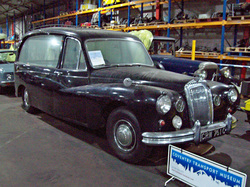 Image: Coventry Transport Museum
Image: Coventry Transport Museum The Daimler DR450, Majestic Major, & Wilcox Limousines
by Chris Jenkins, Editor, RWD
After receiving this story from Paul, and realising I lived only a mile or so from Wilcox Limousines, I dropped in to visit them to see if they had any information about NCJ 700G.
Wilcox Limousines was founded in 1948 by Bill and May Wilcox, having recognised the longevity inherent in this line of business. In those days it was possible to purchase a new chassis and take it to an established coach builder to have a Hearse body built onto it. Soon the franchise for Austin (Vanden Plas Princesses) was obtained and Bill started building his own hearses.
The business moved to it's current premises in Chalfont St. Peter in 1970, and this is where I met current owners, Paul Wilcox and his son Louis, who kindly treated me to a cuppa and a quick tour. Wilcox no longer build coach build cars in Chalfont St. Peter; their ultra modern production facility is now based in Wigan, having moved from Northampton in 2012. There they build up Limousines and Hearses from the latest model Jaguars and consequently have become experts with Aluminium. Wilcox tends to employ ex-Aston Martin engineers and artisans to do their interiors and panel beating by hand, as they still know how to coach build - sadly, a trade that is fading away.
Louis Wilcox confirmed another fact from the story, that hearses are made as "double deckers" - in that they can conceal a second coffin below the one on display, which is for logistical reasons, as when visiting the morgue to collect bodies, often it is easier to pick up the two that they will be taking to be buried that day, instead of going back and forth to the morgue all the time. Some can in fact, take three bodies.
The Daimler Majestic Major was name given to the passenger car variants, while the limousines and hearses were called DR450. Paul Wilcox recalled that the DR450 was made from steel and rotted, adding "it was very heavy, and they went very fast but didn’t stop!".
by Chris Jenkins, Editor, RWD
After receiving this story from Paul, and realising I lived only a mile or so from Wilcox Limousines, I dropped in to visit them to see if they had any information about NCJ 700G.
Wilcox Limousines was founded in 1948 by Bill and May Wilcox, having recognised the longevity inherent in this line of business. In those days it was possible to purchase a new chassis and take it to an established coach builder to have a Hearse body built onto it. Soon the franchise for Austin (Vanden Plas Princesses) was obtained and Bill started building his own hearses.
The business moved to it's current premises in Chalfont St. Peter in 1970, and this is where I met current owners, Paul Wilcox and his son Louis, who kindly treated me to a cuppa and a quick tour. Wilcox no longer build coach build cars in Chalfont St. Peter; their ultra modern production facility is now based in Wigan, having moved from Northampton in 2012. There they build up Limousines and Hearses from the latest model Jaguars and consequently have become experts with Aluminium. Wilcox tends to employ ex-Aston Martin engineers and artisans to do their interiors and panel beating by hand, as they still know how to coach build - sadly, a trade that is fading away.
Louis Wilcox confirmed another fact from the story, that hearses are made as "double deckers" - in that they can conceal a second coffin below the one on display, which is for logistical reasons, as when visiting the morgue to collect bodies, often it is easier to pick up the two that they will be taking to be buried that day, instead of going back and forth to the morgue all the time. Some can in fact, take three bodies.
The Daimler Majestic Major was name given to the passenger car variants, while the limousines and hearses were called DR450. Paul Wilcox recalled that the DR450 was made from steel and rotted, adding "it was very heavy, and they went very fast but didn’t stop!".

It's 4.5 litre hemi-head V8 engine made 220bhp and 283 lb ft of torque. No wonder Paul Edwards found that his hearse left the line well! 0-60 for this 2 ton behemoth was “well under 11 seconds”, and it could reach 114 mph flat out.
Paul Wilcox correctly pointed out that Daimler should have fitted this engine in the SP250 Dart, instead of the smaller 2.5 litre Hemi-headed V8 that it came with. Now that would have been some car, and indeed some people have had this very idea. Click here to hear one run. And click here to ride along in one.
As a result, the DR450 with this hot rod of an engine was not the most popular hearse, as being made of steel it was heavy and drank fuel at a rate of 14.7 miles per gallon! As a result, the aluminium bodied Vanden Plas Princess hearses were far more popular with undertakers as they cost much less to run.
NCJ 700G - the hearse Paul Edwards bought from Wilcox - was taken in part exchange, as Wilcox never built DR450’s themselves. It would have been built by a coachbuilder called Thomas Startin of Birmingham (now called Startin Motor group, no longer a hearse manufacturer); Startin’s were founded back in the 1840s as a horse drawn coach builder.
Paul Wilcox correctly pointed out that Daimler should have fitted this engine in the SP250 Dart, instead of the smaller 2.5 litre Hemi-headed V8 that it came with. Now that would have been some car, and indeed some people have had this very idea. Click here to hear one run. And click here to ride along in one.
As a result, the DR450 with this hot rod of an engine was not the most popular hearse, as being made of steel it was heavy and drank fuel at a rate of 14.7 miles per gallon! As a result, the aluminium bodied Vanden Plas Princess hearses were far more popular with undertakers as they cost much less to run.
NCJ 700G - the hearse Paul Edwards bought from Wilcox - was taken in part exchange, as Wilcox never built DR450’s themselves. It would have been built by a coachbuilder called Thomas Startin of Birmingham (now called Startin Motor group, no longer a hearse manufacturer); Startin’s were founded back in the 1840s as a horse drawn coach builder.
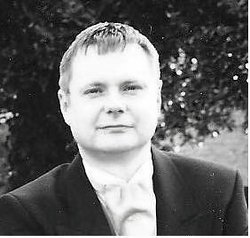
About The Author
Born in Hertfordshire, England in 1964, Paul now lives and works in the rural county of Lincolnshire, where he is best known for the performance art play 'Finding Myself at the Door' and his various musical incarnations.
Presently available from Paul's library are two novels, 'Metropath' and the notoriously strange 'Beyond'; as well as several of his children's titles to include 'Jim's Castle' and 'The Lazy Robot'. Paul Edwards on Amazon
Born in Hertfordshire, England in 1964, Paul now lives and works in the rural county of Lincolnshire, where he is best known for the performance art play 'Finding Myself at the Door' and his various musical incarnations.
Presently available from Paul's library are two novels, 'Metropath' and the notoriously strange 'Beyond'; as well as several of his children's titles to include 'Jim's Castle' and 'The Lazy Robot'. Paul Edwards on Amazon

 RSS Feed
RSS Feed